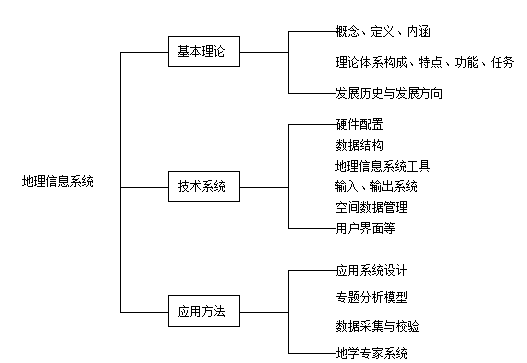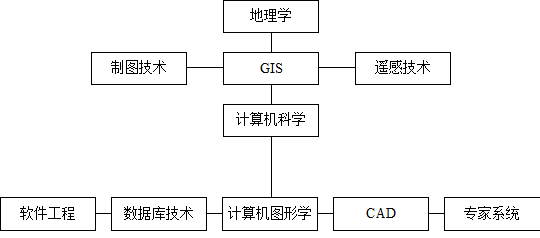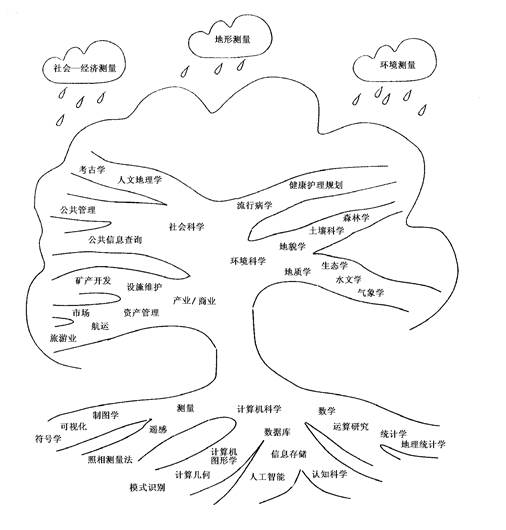Research content of GIS
Research contents
Geographic information systems are produced in the needs of geography research and production practice, the application of geographic information systems has continuously improved the technical system and gradually developed the theory of geographic information systems; theoretical research has also guided the development of a new generation of efficient geographic information systems, and has continued to broaden its application areas and deepen the depth of applications;

Research on basic theory of geographic information system
Including the study of the concept, definition and connotation of Geographic Information System; the study of information theory of Geographic Information System; the establishment of the theoretical system of Geographic Information System; the study of the composition, function, characteristics and tasks of Geographic Information System; the summary of the history of the development of Geographic Information System, and the discussion of the direction of the development of Geographic Information System
GIS technology system design
It includes the design and configuration of GIS hardware, the structure and representation of geospatial data, the input and output system, the spatial database management system, the user interface and user tool design, the development of GIS tool software, the development of micro-computer geographic information system, the development of network geographic information system and so on.
Research on application methods of Geographic Information System
Including application system design and implementation methods; data acquisition and verification; spatial analysis function and thematic analysis model; geographic information system and remote sensing technology integration method; geoscience expert system research.
In a word, the contents of GIS mainly include: related computer software/hardware; spatial data acquisition and computer input; spatial data model and digital expression; data storage and processing in database; data sharing, analysis and application; data display and visualization; geographic information system networking, etc.
GIS related disciplines
Geographic Information System (GIS) is a new technology in geography research that began to develop rapidly in the 1960s, which is the product of the intersection of multiple disciplines. As a combination of traditional science and modern technology, GIS provides new methods for various disciplines involving spatial data analysis, and the development of these disciplines provides some techniques and methods for GIS. In order to better understand and deeply understand the geographic information system, it is necessary to understand and understand the disciplines related to GIS.
Geography is a discipline that studies human life space, the traditional history of geospatial research spatial analysis has a long history. It provides some methods and viewpoints for spatial analysis of GIS, and has become the basis of GIS part theory. Many branches of geography, such as cartography and geodesy, are closely related to GIS. On the other hand, GIS also solves the problem of geography with a new idea and new technical means, so that the mathematical tradition of geography research can be fully utilized, the relevant disciplines of GIS are shown in Figure 1-10.

Geography
Geography is a science that studies the space on which humans depend. In the study of geography, the theory and method of spatial analysis has a long history, which provides the basic viewpoints and methods of spatial analysis for geographic information systems and becomes the basic theoretical basis of geographic information systems. The development of geographic information system also provides a new technical means for the solution of geographical problems, and the mathematical tradition of geography research has been fully exerted.
Within the geography system and its outside world, there is not only the exchange of material and energy, but also the flow of information, this kind of information exchange links many unrelated and irrelevant elements of the system and acts together on the geographic system.
Thus, geographic information system not only expresses the flow of material and energy between natural entities in the form of information, but also reflects the information connection of nature in the most direct way, and quickly simulate the results of the development of this connection, so as to achieve the purpose of geographic prediction.
In a word, there is a profound information connection between nature and human beings. Geographers are facing a physical, that is, the natural, geographic world, while they are feeling a geographic information world. Geographic research is actually based on this information world which coexists with the real world and is equivalent in the sense of information. GIS expresses the geographical real world in the geographic information world, and can simulate various natural processes and thinking processes in a real and rapid way, which plays an important role in geographic research and prediction.
Cartography
Maps are a form of graphic language for recording geographic information, from the perspective of historical development, geographic information systems are born out of maps, cartography theory and methods have an important impact on the development of geographic information systems. GIS is another new form of map information, which has the function of storing, analyzing, displaying and transmitting spatial information, especially computer graphics provides a series of methods for digital representation, operation and display of map features, the graphical output design of the system provides technical support; at the same time, maps are still one of the important sources of data for current GIS. But there are essential differences between the two: the map emphasizes data analysis, symbolization and display, while the geographic information system focuses on information analysis.
Maps are a common means of understanding and analyzing the objective world, although there have been various changes in the form of maps,which can be considered that there are three main factors that constitute maps: map graphics, mathematical elements and auxiliary elements. The map graphic is the content part (also known as the geographical element) of the distribution, connection and time change of various natural and socio-economic phenomena in the drawing area represented by the map symbol, such as rivers and mountains, plains, soil vegetation, residential areas, roads, administrative boundaries, or other thematic content, etc., which are the main parts of the map components. The mathematical element is the mathematical basis for determining the position and geometric accuracy of the graphic, and is the “skeleton” of the map. These include map projections and coordinate networks, scales, and earth control points. Map projection is the mathematical method of mapping the image on the ellipsoid of the earth to a plane; the coordinate network is the mathematical basis of various maps and is an indispensable element on the map; the scale indicates the degree of reduction of the coordinate network and the map graphic; the earth control point is to ensure that the natural surface of the earth is transferred to the ellipsoid surface and then transferred to the plane rectangular coordinate network with precise geographical position. Auxiliary elements are set for easy reading and drawing. The illustration is a description of the various symbols showing the contents of the map, as well as the name of the map, the map compiling and publishing unit, the time of the drawing and the information used, and the date of publication. Some maps also have additional information to supplement and enrich the content of the map. For example, draw some supplementary maps or sections, charts, etc. in the blanks of the figure or in the outline of the figure.Sometimes there are some forms or key words in one aspect.
It can be seen from the development process of GIS that there is a close relationship between the generation and development of GIS and the mapping system, the similarities between the two are based on the expression, display and processing of spatial databases. From the perspective of system composition and function, a geographic information system has all the components and functions of the machine assisted mapping system, and the geographic information system also has the function of data processing. Map is a kind of graphic image, a geographical model of scientific abstraction and symbolic representation of the real world according to geographical thoughts, the product of geographical thinking and the efficient carrier of geographic information in the physical world, the map can be from different aspects and different topics, systematic recording and transmission of historical, historical and planned predicted geographic landscape information of the physical world.
Computer science
The creation and development of GIS technology is inseparable from the continuous development of the expression, processing, analysis and application of geospatial information. In the early 1960s, computerized digital maps appeared on the basis of computer graphics. Geographic information systems are closely related to computer database technology (DBMS), computer-aided design (CAD), computer-aided drafting (CAM), and computer graphics. But they cannot replace the role of geographic information systems.
The Database Management System is a software system that operates and manages databases, which provides a software system that can be invoked by multiple applications and users to support the creation, update, and query of databases that can be called by multiple applications and users, maintenance function, GIS draws on the theory and method of DBMS in data management, non-geometric attribute data is sometimes managed by general DBMS or software system developed on it; for the management of spatial geographic data, the general DBMS has two obvious weaknesses: first, the lack of spatial entity definition ability: the current popular network structure, hierarchical structure, relationship structure, etc., it is difficult to describe the spatial structure comprehensively, flexibly and efficiently; second, the lack of spatial relationship query capability: the general DBMS query is mainly for entity query, while the GIS requires querying the spatial relationship of the entity, such as orientation, distance, tolerance, neighboring, intersecting and spatial coverage. Etc., obviously, it is difficult for general DBMS to implement spatial data query and spatial analysis. Data is the carrier of information, which can be interpreted to extract information, the general database and the geodatabase are all managed by the data itself, on the basis of data management, GIS generates useful geographic information and obtains information through geographic model operations, how much and quality are closely related to the level of the geographic model.
Computer graphics is a technology that uses computer to process graphical information and human-machine communication processing with graphical information. It is the basis of GIS algorithm design. GIS is constantly developing along with the development of computer graphics technology, but the graphic data processed by computer graphics is a pure geometric figure that does not contain geographical attributes, it is a geometric abstraction of geospatial data, which can realize the graphics operation of GIS underlying, however, the geographical model analysis of data and many geographically significant data processing cannot be completed and cannot constitute a complete GIS.
Computer-Aided Design (CAD) is designed by computer-aided designers to improve the automation of the design, saving manpower and time; computer-Aided Mapping, which is specifically used for drawing, uses a computer to edit and draw geometric figures. The difference between GIS and CAD and CAM is: First, CAD cannot establish geographic coordinate system and complete geographic coordinate transformation; Second, the data volume of GIS is much larger than that of CAD and CAM, the structure is more complicated, and the data is closely related, which is because GIS involves a wide range of areas, high precision requirements, complex changes, numerous elements, and interrelated, and single structure is difficult. Full description; third, CAD and CAM do not have the spatial query and analysis capabilities of GIS.
Remote sensing
Remote sensing is a new type of detection technology that does not obtain information through direct contact with the target. It usually refers to the information that acquires and processes the surface of the Earth, especially the natural resources and the human environment, and finally the technology on the photo or digital image. Images often require further processing before they can be used, and the technique used for this purpose is called image processing. Image processing includes various operations that can process a photo or digital image, including image compression, image storage, image enhancement, processing, and quantitative image pattern recognition. At present, remote sensing has become an extremely valuable tool in environmental research, and professionals in different disciplines have continuously discovered the potential applications of different data for airborne remote sensing in various fields. Remote sensing and image processing techniques are used to acquire and process information related to the Earth’s surface;the development of GIS stems from the need for integration and spatial analysis of land attribute information and corresponding geometric expressions. These two technologies have developed independently in the past, although they are actually complementary. From the perspective of GIS itself, with the development and deepening of its application field, whichi first requires storing a large amount of relevant data, and through continuous accumulation and extension, which has the ability to reflect the trend of natural historical process and human influence, revealing the inherent law of the development of things. However, the GIS database is almost exclusively established through map digitization, users cannot access the original data and related information, and the original data in the GIS is the basis for effectively simulating and controlling the error propagation. Secondly, in order to maintain the dynamic and current situation of the system, GIS also requires timely updating of the data in the system, at present, the information stored in the GIS is only a static model of the real world, which needs to be updated regularly or in time. As a powerful means of acquiring and updating spatial data, remote sensing can provide various resources and environmental data that are accurate, comprehensive and widely detected in a wide range of time, therefore, remote sensing information becomes a very important source of information for GIS. On the other hand, the data in GIS can be used as an auxiliary data for remote sensing image analysis. In the integration process of the two, GIS is mainly used for data processing, operation and analysis; remote sensing is used as a means of data acquisition, maintenance and updating of data in GIS, in addition, GIS can be used for knowledge-based remote sensing image analysis. Geographic information system and remote sensing are two technological fields developed independently, with the continuous development of their application fields and their own development, they are deepening and improving from qualitative to quantitative, from static to dynamic, from current situation description to prediction and prediction. Their combination has gradually evolved from a low-level to an advanced stage. The combination of remote sensing and geographic information systems has evolved from a low-level to an advanced stage. The earliest combination work consisted of visually interpreting and processing aerial remote sensing images into various types of thematic maps, then digitizing and inputting them into geographic information systems; since the mid-to-late 70s, various image analysis systems have developed rapidly and extensively. A large number of remote sensing data and various types of thematic information formed by image classification of image analysis systems can be directly input into the geographic information system. The whole process can be carried out in an “all-digital” environment, and image data can be displayed on the screen for generating an edit map, the combination of remote sensing and geographic information systems has entered a new phase.
As a means of spatial data acquisition, remote sensing has become the main information source and data update way of GIS. Remote sensing image processing system contains several complex analytical functions, and there are many methods for information enhancement and classification. In addition, geodesy provides a precise positioning control system for geographic information systems, especially the global positioning system (GPS) can quickly and cheaply acquire the familiar position information of surface features. The application of aerial photographs and their precise measurement methods makes photogrammetry the main terrain data source of Geographic Information System (GIS). In a word, remote sensing is the main data source and renewal means of Geographic Information System. At the same time, the application of Geographic Information System further supports the comprehensive development and utilization of remote sensing information.
Management science
Traditionally, management information system (MIS) aims at management and has the ability to store, process, manage and analyze data with the support of computer hardware and software, such as talent management information system, financial management information system, service management information system, etc. The greatest feature of this kind of information system is that it processes data without or without spatial features.
Another kind of management information system is an information system which is supported by geographic information system with spatial analysis function and aims at management. It uses various functions of geographic information system to process and analyze elements with spatial characteristics in order to achieve the purpose of managing regional system, such as urban traffic management information system, urban water supply management information system and water-saving agriculture management. Information system, etc.
In fact, the relationship between GIS and other disciplines can be visually represented by a tree, as shown in Figure 1-11.

As mentioned in the figure above, “tree root” represents the technical basis of GIS, such as surveying, computer science and mathematics; “tree branch” represents the application of GIS, and the result and demand of application return to “tree root”; raindrop is the data source of each application, such as various surveys such as topographic survey, environmental survey, etc., and provides an effective means for its development, while Geographic Information System (GIS) The application of the system is mainly in the fields of environmental science, geography and social sciences.